Searching for "information literacy"
Competent, Literate, Fluent: The What and Why of Digital Initiatives
Morris Pelzel Published: Wednesday, April 17, 2019
https://er.educause.edu/blogs/2019/4/competent-literate-fluent-the-what-and-why-of-digital-initiatives
how should associated terms including literacy, competency, and fluency be distinguished
In the 2019 EDUCAUSE Learning Initiative (ELI) Key Issues in Teaching and Learning, digital and information literacy maintains a top-five position for the third consecutive year.
Is it significant that Bryn Mawr College has a framework for digital competencies, Virginia Tech is launching a program in digital literacy, and the University of Mary Washington has a curricular initiative for advanced digital fluency? And what does it mean that Penn State has shifted its focus from digital literacy to digital fluency?
Jennifer Sparrow and Clint Lalonde have argued that digital fluency is a distinct capacity above and beyond digital literacy.
digital frameworks … on three levels:
- First, digital initiatives aim to enhance students’ success after graduation.
- A second major objective is to develop “digital citizenship.”
- At a third level, digital initiatives can promote deep reflection upon the distinctive nature and ethics of knowing and knowledge in the digital age.
Library 2.019 virtual mini-conference, “Shaping the Future of Libraries with Instructional Design
Wednesday, March 13th, from 12:00 – 3:00 pm US Pacific Daylight Time (click https://www.timeanddate.com/worldclock/fixedtime.html?msg=Library+2.019+ID&iso=20190313T12&p1=283&ah=3 to see in your local time zone).
Here are the links to the recordings of the sessions:
https://www.library20.com/page/recordings-id (you must be logged in)
This is a free event, thanks to our founding conference sponsor: School of Information at San José State University.
ATTENDING: We will send links for attending the conference a day or two before the event.
If you have friends or colleagues that wish to attend, this is a free event and we encourage you to share our information widely. However, please send them to the conference registration page (https://www.library20.com/instructionaldesign) rather than giving them the above link directly as it will allow us to track participation.
https://www.library20.com/instructionaldesign
https://www.library20.com/forum/categories/library-2-019-instructional-design-accepted-submissions/listForCategory
#library2019 #libraryid

Dana Bryant
Sandy Hirsch, SJSU School of Information.
Steven Bell, John Shank – integrating ID into practice. blended librarianship.
critical mass of librarians doing ID and libraries hiring IDs.
Michael Flierl
Assistant Professor of Library Science, Purdue University
Dana Bryant
Lead Instructional Technologist for Academic Technology Services, Woodruff Library, at Emory University
Lindsay O’Neill
Faculty, California State University, Fullerton’s Master of Science in Instructional Design and Technology Program
Steven J. Bell (moderator)
Associate University Librarian for Research and Instructional Services at Temple University
https://www.library20.com/page/library-2-0-schedule-gmt-4
What is ID: ID create an environment conductive to students’ success. Thoughtful and applied design. Making faculty and instructors’ life easier. Allow faculty to do what they do best.
Lindsey: solving the instructional problem with the tools at hand.
go-to ed tech? What is the hot tech right now?
Lindsey: H5P (open source) CC – licensed, Moodle, WordPress, build online tutorials for free (Isolde), Norway, well based, VR tours. Will H5P become paid? Michael: cell phones Dana: Emory VoiceThread. From the chat: Articulate365 (pricy), Kahoot, Peardeck, Yellowdig, vidgrid, Adobe Spark, Adobe POst, padlet, Groupme instead of Canvas, Vyond, Coggle, wakelet, Phinx
Suggestions for librarians who want to build ID skills. Dana: connect with the regional community if no ID on campus. Community of practice. Using ID tools, speakers outside of campus. Lindsey: teaching myself what is most interesting to me. what technologies are important. Find a learning community. Michael: repeat the others
keep up to date on ID theory and practices: Dana – ELI, OLC (Online Learning Consortium). ELearning Heroes. Lindsay: corporate word. Michael: POD
the one-shot instruction: what is the approach (q/n from the chat); Dana – ID as a services. person dedicated following up with people requested either ID class or training, open the line of communication. summative evaluation type of activity since we are failing to evaluate how well students absorbed the information. LIndsey: one-shot for basics (e.g. freshman), build scaffold program, reserved the one shot for meeting with librarians, for hands-on. Michael: work with faculty member and rewrite a program, build assessment rather then only deliver
areas of impact: subject matter librarians, working with faculty to use of the library resources, new faculty drawn in info and if not follow up, Canvas support. Michael: librarians and ID working directly with faculty rewriting their curricula, measure it, demonstrating library need, 3000 students – correlation. document the lib contribution to student learning directly, the teaching-learning culture change. using info and data in more authentic ways. Lindsey: disconnect the way librarian teach vs faculty teach. Coordination scaffolding.
q/n from the chat. easily. how can non ID librarian can easily implement ID type:
Lindsey: new to ID? Google. Jargon and Acronyms. re framing how you see ed technology. technology as something to get the job done. no need to get fancy.
Dana: same as Lindsey. But also learning theories and learning outcomes. From ID perspective: what they will come out with by the end of the session. action words.
Michael: mindset. what students want to learn, before what I will teach. backward design – understanding by design. UDL. Grab a friend and talk through.
Tara
ed tech is not getting job done:
clickers for attendance is horrible idea.
from the chat:
Dee Fink’s Taxonomy of Significant Learning1
https://www.byui.edu/outcomes-and-assessment-old/the-basics/step-1-articulate-outcomes/dee-finks-taxonomy-of-significant-learning
https://www.alt.ac.uk/
Association of Talent Development
Christy Tucker’s blog – Experiencing E-Learning
https://www.issotl.com/2019
https://e-learning.zeef.com/tracy.parish
https://www.lib.umich.edu/blogs/tiny-studies/using-pilot-study-test-and-assess-new-instruction-model
http://suny.edu/emtech
I had a really interesting role in grad school where we lived in the land between tech support and pedagogical / design support.
From Rajesh Kumar Das to All panelists and other attendees: (02:38 PM)
Good to hear from mike about affective learning. In this case, could you please focus what kind of technique is approprite for what, i.e. Didactic instruction, a low-complexity teaching technique such as a “Quiz Bowl”, or Jigsaw Method as high-complexity strategy, or both.
From Hailey W. to All panelists and other attendees: (02:36 PM)
As an ID librarian and the campus LMS administrator I struggle with getting them to see that other side of my role. That I’m not just “tech support”. Anyone else? Een jsut not being tech support?
From Vickie Kline to All panelists and other attendees: (02:44 PM)
As a librarian not formally trained in ID, I think a good entry point for exploring is Universal Design for Learning. We also need to pay attention to creating accessibility materials…
From Heather Quintero to All panelists and other attendees: (02:45 PM)
I always start with ADDIE… I am formally trained in ID and am an IT trainer for librarians. ADDIE is a framework for every class I make for both live and online classes. Don’t disregard ADDIE.
From Allison Rand to All panelists and other attendees: (02:47 PM)
The Wiggins and McTighe is a great book!
ADDIE Model
From Shane to All panelists and other attendees: (02:48 PM)
++SLIS open-source course on Instructional Design for Library Instruction
From Wendy to All panelists and other attendees: (02:49 PM)
Char Booth’s USER is also a very good model
http://www.modernlearning.com
https://web.mit.edu/jbelcher/www/TEALref/Crouch_Mazur.pdf
From Roberta (Robin) Sullivan to All panelists and other attendees: (02:53 PM)
@Rachel, Peggy, Shane – an open source course is available. Check out the SUNY’s Quality by Design (QbD): Strategies for Effective Teaching and Quality Course Design at: http://suny.edu/qbd This course is available as a facilitated version at least once each semester and as a self-paced non-facilitated version in Blackboard’s CourseSites. After completing the course requirements you can earn a Digital Badge to show your accomplishment.
From Naomi Toftness to All panelists and other attendees: (02:55 PM)
Just heard the terms “deliberate innovation” vs. “desperate innovation” that totally speaks to my situation with wanting to adopt the new cool tech
++++++++++++++++++++++
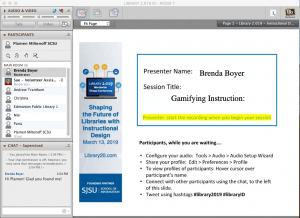 SESSION LINK – https://sas.elluminate.com/d.jnlp?sid=2008350&password=LIB2019IDPart7 — If the session link doesn’t work for you, please copy and paste into your browser.
SESSION LINK – https://sas.elluminate.com/d.jnlp?sid=2008350&password=LIB2019IDPart7 — If the session link doesn’t work for you, please copy and paste into your browser.
Session Title: Gamifying Instruction: Breakouts and Badges!
Your Name and Title: Dr. Brenda Boyer, Librarian & Instructor
Your Library, School, or Organization Name: Kutztown Sr. High School, Rutgers University
Your Twitter Handle (@name): @bsboyer
Name(s) of Co-Presenter(s): Brenda Boyer
Area of the World from Which You Will Present: Kutztown, PA
Language in Which You Will Present: English
Target Audience: Instructional Design Librarians
Short Session Description: Build engagement for your online library instruction using LMS features, Breakout boxes, and digital badges.
Session Strand (use the “tag”): {Session Strand (use the “tag”):}
Full Session Description: It’s time to amp up your library instruction! Gamifying instruction in research skills such as database usage, advanced searching, & more can increase engagement and drive independent learning for students of all ages. This session will describe how learning management system (LMS) features can be combined with digital microcredentials (i.e. badges) and breakout boxes to gamify instruction that can be otherwise deemed boring (for both the learners and the librarian!).
Link to Conference Site Session Proposal (full URL with http://): https://www.library20.com/forum/topics/gamifying-instruction-breakouts-and-badges
Other Websites / URLs Associated with Your Session:
Your Bio: Dr. Brenda Boyer is a librarian and instructional designer. She has developed online instruction for secondary learners in the Kutztown (PA) School District, as well as for graduate and professional development learners at Wilson College and Rutgers University. She designed and instructs the Rutgers graduate course, Learning Theory, Inquiry, & Instructional Design, and is a frequent presenter at AASL, Internet@Schools. She has published articles in School Library Journal, Teacher Librarian, and School Library Connection.
Email: boyer.brenda@gmail.com
notes from Brenda’s session:
are we getting the job done, is our instruction sticking, what evidence we do have?
differentiate: who is ready to do what” at what skill level? how to bring everybody up to speed?
3 elements of Digital Gamification: leverage LMS (set game levels); how digital badges are paired 3. using digital breakout boxes to push challenge, skills
each chat as prerequisite for the next. prerequisite in LMS. Each game level is module. completed with a quizz. if they pass the quiz, opens challenge.1. what is page (facts about a tool to learn about[ what the tool does, feature, etc.) 2. suppe rshort video tour (3 min max), talk about something unique 3. quick quiz (max 5 q/s from the intro page and video). pass the quiz (100 %) to unlock the challenge level. 4. challenge level. digital breakout box embedded in the LMS. breakout using Google Forms. various locks (words, letter, numbers)

Badges why?
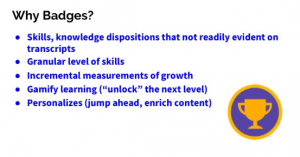
 Badgr, Credly, iDoceo
Badgr, Credly, iDoceo
Breakout Boxes

++++++++++++++++++++++
SESSION LINK – https://sas.elluminate.com/d.jnlp?sid=2008350&password=LIB2019IDPart8 — If the session link doesn’t work for you, please copy and paste into your browser.
Session Title: Improving Library Tutorials: The Multimedia Design Principles
Your Name and Title: Darlene Aguilar, Instructional Design Librarian
Your Library, School, or Organization Name: Loyola Marymount University
Your Twitter Handle (@name): @DarleneA_ID
Name(s) of Co-Presenter(s):
Area of the World from Which You Will Present: Los Angeles, CA
Language in Which You Will Present: English
Target Audience: Reference and Instruction Librarians, Instructional Designers, Tutorial developers, Academic Librarians
Short Session Description: This session will review Mayer’s (2001) Multimedia Design Principles to help improve instructional modules, tutorials, and videos.
Session Strand (use the “tag”): {Session Strand (use the “tag”):}
Full Session Description: Librarians are creating more online modules, videos, and tutorials to teach information literacy skills. Whether designing instruction online or in-person, research-based instructional methods are required and learning Mayer’s Multimedia Design Principles is the best place to start. In this session, I will review essential prior-knowledge on image types and working memory. I will then show learners how to minimize cognitive overload using these 12 principles: multimedia, spatial contiguity, temporal contiguity, coherence, modality, redundancy, individual differences, signaling, pacing, concepts first, personalization, and human voice.
Link to Conference Site Session Proposal (full URL with http://): https://www.library20.com/forum/topics/improving-library-tutorials-the-multimedia-design-principles
Other Websites / URLs Associated with Your Session: https://linkedin.com/in/darlene-aguilar/
Your Bio: Darlene Aguilar is an Instructional Design Librarian at Loyola Marymount University where she designs and develops video tutorials and online modules on information literacy and library related topics. Additionally, she provides “best practices” training in instructional design to other LMU librarians. She graduated from the University of Southern California with a Master’s in Education for Learning Design and Technology and previously worked at LAUSD for 7 years. She strives to remove learning barriers that are embedded in instruction and curriculum and make learning accessible to all learners.
Email: darlene.aguilar@lmu.edu
notes from Darlene Aguilar session: spacial contiguity, temporal contiguity. Modality: animation + narration better then animation + text, redundancy: animation and narration then animation + narration + text

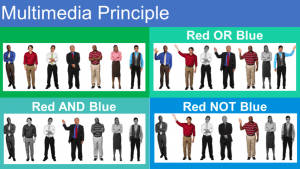
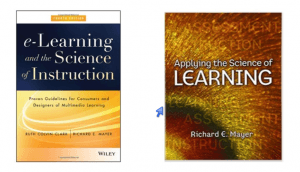
https://events.educause.edu/eli/annual-meeting/2019/programs-and-tracks
- What new kinds of leadership are required for this new teaching and learning landscape?
- What are the best methods and techniques that promote innovation and creative thinking to support student learning?
- What new educational technologies seem most promising?
- What role should data and analytics play, and what are the trade-offs between analytics and privacy?
- How can we best determine the efficacy of our learning innovations and technologies?
- What learning spaces and environments best promote active learning
2019 ELI Annual Meeting Tracks
- Accessibility and Universal Design for Learning (UDL)
- Analytics: Privacy, Learning Data, Student Advising, and Interventions
- Digital and Information Literacy
- Faculty Development and Engagement
- Innovation in Instructional Design and Course Models
- Leadership and Academic Transformation
- Learning Efficacy: Impact Evaluation, Learning Research and Science
- Learning Environments and Spaces
- Learning Horizons: Emerging Technology, Ground-Breaking Practices, and Educational Futures
- Open Education
- Student Success
Other sessions for Dr. James Johnson’s classes:
https://blog.stcloudstate.edu/ims?s=jim+johnson
other sessions for EDAD courses:
https://blog.stcloudstate.edu/ims?s=digital+literacy+edad
How do we search?
Academic Social Sites: https://blog.stcloudstate.edu/ims/2018/11/13/scsu-edad-scopus-vs-academia-vs-researchgate/
Google. term:gov term:edu term:org
https://toolbox.google.com/datasetsearch
https://blog.stcloudstate.edu/ims/2018/04/02/publish-metrics-ranking-and-citation-info/
How do we work/collaborate? (digital literacy)
Zoom, Skype Pro, Google Hangouts, Adobe Connect
Zotero, Mendeley (Scopus), Refworks, Endnote
http://orcid.org/register
Trends:
UDL (Universal Design for Learning): https://blog.stcloudstate.edu/ims?s=universal+design
mind mapping: Coggle: https://blog.stcloudstate.edu/ims/2019/03/13/coggle-mindmap/
notetaking, mindmapping etc for you and your students: https://blog.stcloudstate.edu/ims/2019/08/29/note-taking-in-classes/
Key Issues in Teaching and Learning
https://www.educause.edu/eli/initiatives/key-issues-in-teaching-and-learning
A roster of results since 2011 is here.
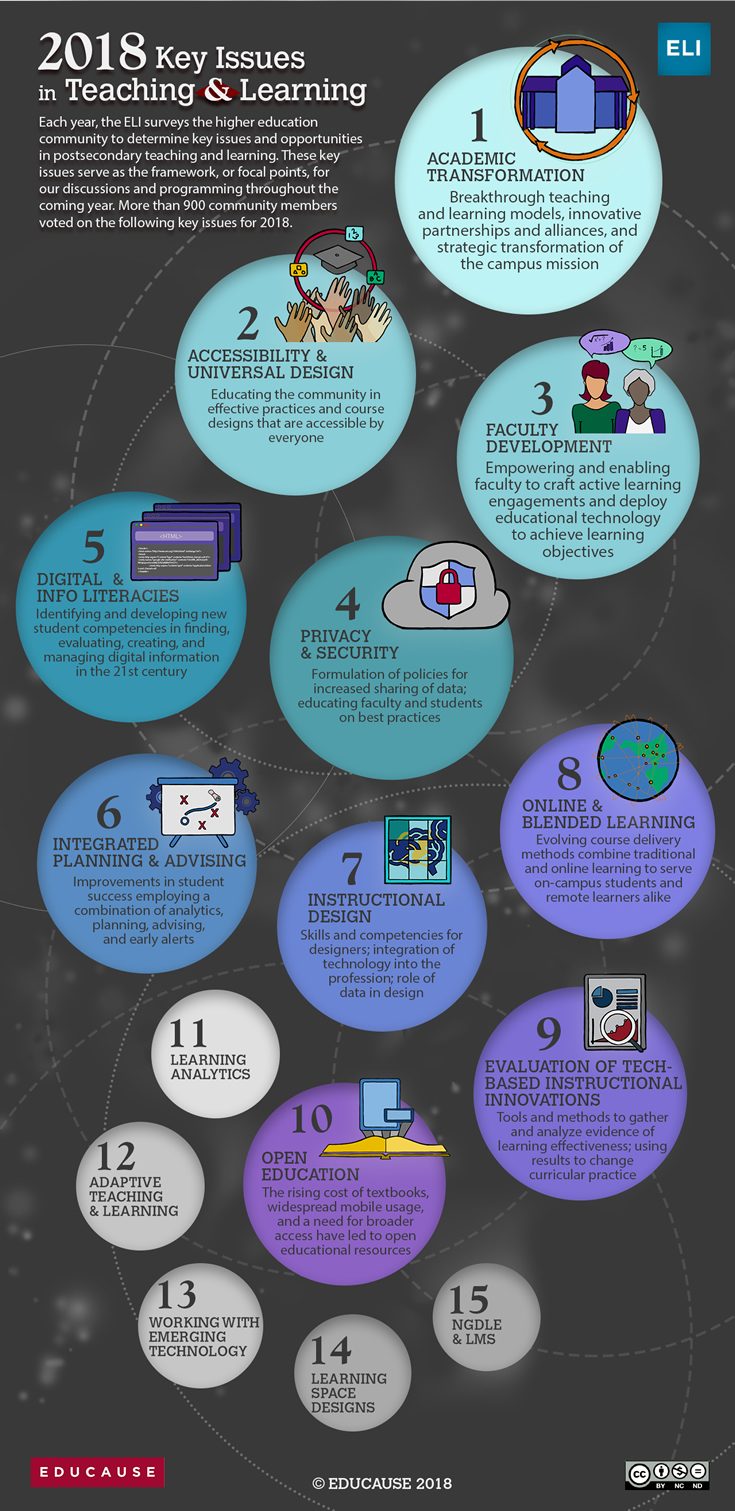
1. Academic Transformation
2. Accessibility and UDL
3. Faculty Development
4. Privacy and Security
5. Digital and Information Literacies
https://cdn.nmc.org/media/2017-nmc-strategic-brief-digital-literacy-in-higher-education-II.pdf
Three Models of Digital Literacy: Universal, Creative, Literacy Across Disciplines
United States digital literacy frameworks tend to focus on educational policy details and personal empowerment, the latter encouraging learners to become more effective students, better creators, smarter information consumers, and more influential members of their community.
National policies are vitally important in European digital literacy work, unsurprising for a continent well populated with nation-states and struggling to redefine itself, while still trying to grow economies in the wake of the 2008 financial crisis and subsequent financial pressures
African digital literacy is more business-oriented.
Middle Eastern nations offer yet another variation, with a strong focus on media literacy. As with other regions, this can be a response to countries with strong state influence or control over local media. It can also represent a drive to produce more locally-sourced content, as opposed to consuming material from abroad, which may elicit criticism of neocolonialism or religious challenges.
p. 14 Digital literacy for Humanities: What does it mean to be digitally literate in history, literature, or philosophy? Creativity in these disciplines often involves textuality, given the large role writing plays in them, as, for example, in the Folger Shakespeare Library’s instructor’s guide. In the digital realm, this can include web-based writing through social media, along with the creation of multimedia projects through posters, presentations, and video. Information literacy remains a key part of digital literacy in the humanities. The digital humanities movement has not seen much connection with digital literacy, unfortunately, but their alignment seems likely, given the turn toward using digital technologies to explore humanities questions. That development could then foster a spread of other technologies and approaches to the rest of the humanities, including mapping, data visualization, text mining, web-based digital archives, and “distant reading” (working with very large bodies of texts). The digital humanities’ emphasis on making projects may also increase
Digital Literacy for Business: Digital literacy in this world is focused on manipulation of data, from spreadsheets to more advanced modeling software, leading up to degrees in management information systems. Management classes unsurprisingly focus on how to organize people working on and with digital tools.
Digital Literacy for Computer Science: Naturally, coding appears as a central competency within this discipline. Other aspects of the digital world feature prominently, including hardware and network architecture. Some courses housed within the computer science discipline offer a deeper examination of the impact of computing on society and politics, along with how to use digital tools. Media production plays a minor role here, beyond publications (posters, videos), as many institutions assign multimedia to other departments. Looking forward to a future when automation has become both more widespread and powerful, developing artificial intelligence projects will potentially play a role in computer science literacy.
6. Integrated Planning and Advising Systems for Student Success (iPASS)
7. Instructional Design
8. Online and Blended Learning
In traditional instruction, students’ first contact with new ideas happens in class, usually through direct instruction from the professor; after exposure to the basics, students are turned out of the classroom to tackle the most difficult tasks in learning — those that involve application, analysis, synthesis, and creativity — in their individual spaces. Flipped learning reverses this, by moving first contact with new concepts to the individual space and using the newly-expanded time in class for students to pursue difficult, higher-level tasks together, with the instructor as a guide.
Let’s take a look at some of the myths about flipped learning and try to find the facts.
Myth: Flipped learning is predicated on recording videos for students to watch before class.
Fact: Flipped learning does not require video. Although many real-life implementations of flipped learning use video, there’s nothing that says video must be used. In fact, one of the earliest instances of flipped learning — Eric Mazur’s peer instruction concept, used in Harvard physics classes — uses no video but rather an online text outfitted with social annotation software. And one of the most successful public instances of flipped learning, an edX course on numerical methods designed by Lorena Barba of George Washington University, uses precisely one video. Video is simply not necessary for flipped learning, and many alternatives to video can lead to effective flipped learning environments [http://rtalbert.org/flipped-learning-without-video/].
Myth: Flipped learning replaces face-to-face teaching.
Fact: Flipped learning optimizes face-to-face teaching. Flipped learning may (but does not always) replace lectures in class, but this is not to say that it replaces teaching. Teaching and “telling” are not the same thing.
Myth: Flipped learning has no evidence to back up its effectiveness.
Fact: Flipped learning research is growing at an exponential pace and has been since at least 2014. That research — 131 peer-reviewed articles in the first half of 2017 alone — includes results from primary, secondary, and postsecondary education in nearly every discipline, most showing significant improvements in student learning, motivation, and critical thinking skills.
Myth: Flipped learning is a fad.
Fact: Flipped learning has been with us in the form defined here for nearly 20 years.
Myth: People have been doing flipped learning for centuries.
Fact: Flipped learning is not just a rebranding of old techniques. The basic concept of students doing individually active work to encounter new ideas that are then built upon in class is almost as old as the university itself. So flipped learning is, in a real sense, a modern means of returning higher education to its roots. Even so, flipped learning is different from these time-honored techniques.
Myth: Students and professors prefer lecture over flipped learning.
Fact: Students and professors embrace flipped learning once they understand the benefits. It’s true that professors often enjoy their lectures, and students often enjoy being lectured to. But the question is not who “enjoys” what, but rather what helps students learn the best.They know what the research says about the effectiveness of active learning
Assertion: Flipped learning provides a platform for implementing active learning in a way that works powerfully for students.
9. Evaluating Technology-based Instructional Innovations

What is the total cost of my innovation, including both new spending and the use of existing resources?
What’s the unit I should measure that connects cost with a change in performance?
How might the expected change in student performance also support a more sustainable financial model?
The Exposure Approach: we don’t provide a way for participants to determine if they learned anything new or now have the confidence or competence to apply what they learned.
The Exemplar Approach: from ‘show and tell’ for adults to show, tell, do and learn.
The Tutorial Approach: Getting a group that can meet at the same time and place can be challenging. That is why many faculty report a preference for self-paced professional development.build in simple self-assessment checks. We can add prompts that invite people to engage in some sort of follow up activity with a colleague. We can also add an elective option for faculty in a tutorial to actually create or do something with what they learned and then submit it for direct or narrative feedback.
The Course Approach: a non-credit format, these have the benefits of a more structured and lengthy learning experience, even if they are just three to five-week short courses that meet online or in-person once every week or two.involve badges, portfolios, peer assessment, self-assessment, or one-on-one feedback from a facilitator
The Academy Approach: like the course approach, is one that tends to be a deeper and more extended experience. People might gather in a cohort over a year or longer.Assessment through coaching and mentoring, the use of portfolios, peer feedback and much more can be easily incorporated to add a rich assessment element to such longer-term professional development programs.
The Mentoring Approach: The mentors often don’t set specific learning goals with the mentee. Instead, it is often a set of structured meetings, but also someone to whom mentees can turn with questions and tips along the way.
The Coaching Approach: A mentor tends to be a broader type of relationship with a person.A coaching relationship tends to be more focused upon specific goals, tasks or outcomes.
The Peer Approach:This can be done on a 1:1 basis or in small groups, where those who are teaching the same courses are able to compare notes on curricula and teaching models. They might give each other feedback on how to teach certain concepts, how to write syllabi, how to handle certain teaching and learning challenges, and much more. Faculty might sit in on each other’s courses, observe, and give feedback afterward.
The Self-Directed Approach:a self-assessment strategy such as setting goals and creating simple checklists and rubrics to monitor our progress. Or, we invite feedback from colleagues, often in a narrative and/or informal format. We might also create a portfolio of our work, or engage in some sort of learning journal that documents our thoughts, experiments, experiences, and learning along the way.
The Buffet Approach:
10. Open Education

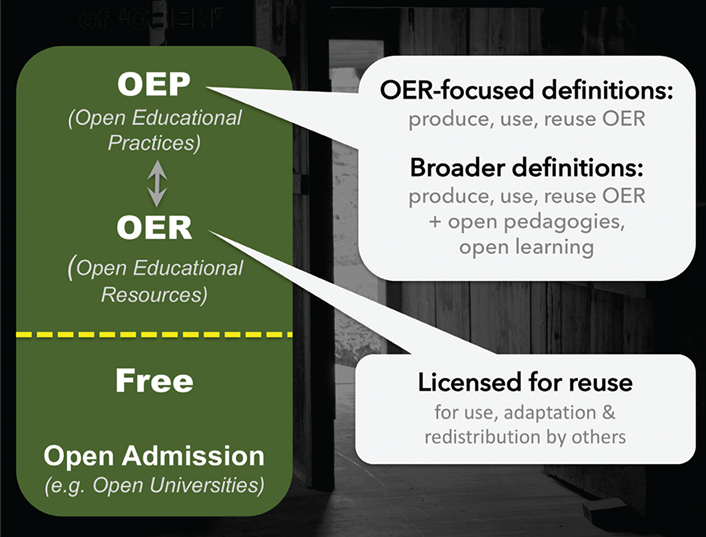
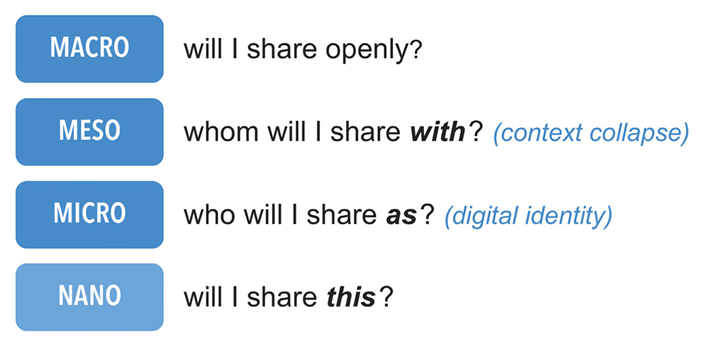
11. Learning Analytics
12. Adaptive Teaching and Learning
13. Working with Emerging Technology
In 2014, administrators at Central Piedmont Community College (CPCC) in Charlotte, North Carolina, began talks with members of the North Carolina State Board of Community Colleges and North Carolina Community College System (NCCCS) leadership about starting a CBE program.
Building on an existing project at CPCC for identifying the elements of a digital learning environment (DLE), which was itself influenced by the EDUCAUSE publication The Next Generation Digital Learning Environment: A Report on Research,1 the committee reached consensus on a DLE concept and a shared lexicon: the “Digital Learning Environment Operational Definitions,
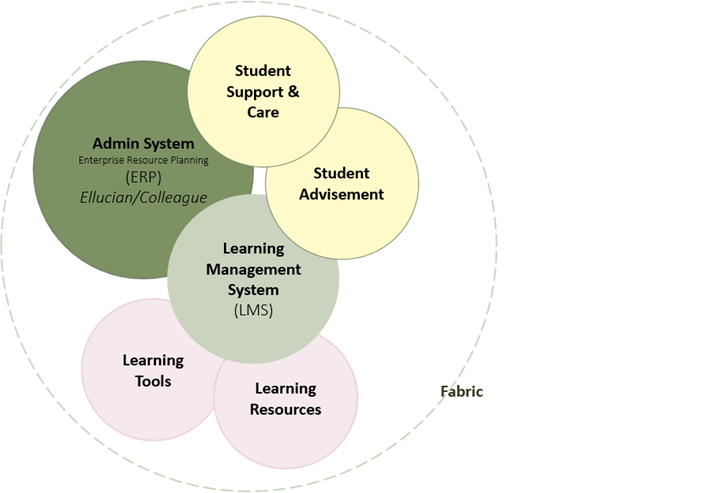
Midpoint Reflection
https://canvas.instructure.com/courses/1288387/assignments/8024238?module_item_id=16052093
While it may take time to do this reflection, it can have many important benefits: 1) research shows that reflecting on experiences creates an environment in which insights and creativity can flourish; 2) taking a moment to consider the positive experiences (and to learn from the challenging ones) generates positive emotions which can benefit everyone during highly stressful moments in the semester; and 3) your experiences in narrative form provide insights to the committee beyond what is possible through surveys. This helps us to tailor the program in the future.
Here are a few questions/topics you should consider in your reflection:
- How well is the program working for you so far?
I was not able to collaborate last year, but this year it has been perfect match with my ID2ID buddy Aura Lippincott. It is just marvelous to work with same-minded and driven person
- What have you accomplished so far?
We are well underway with one of our two projects – the VRrelax one the project each of us is teaming up with faculty and staff from our universities. We plan to roll out the test at the end of this month (October), do the research in November and compare notes and results in December. The project aims to establish if VR delivered by Oculus Go may have positive impact on stress reduction for students.
Our second project, the Open Learning one is also gathering speed; we intend to have a research topic determined by the end of the month, while we are gathering resources at the time being.
- What else do you need to do? Describe the progress you have made toward meeting your program goals.
Each of us is in a daily contact with faculty and staff, searching for the right people to build a team. By mid September, we were able to start forming the research questions with the team and establish responsibilities and deadlines. We keep track of the progress via Google Docs: https://docs.google.com/document/d/1kOgqC7vUaBtOEDaB6ZF-ayEyVw2yBmB0fHXWrrcFkB4/edit and https://docs.google.com/document/d/1huFe1bPE08ha9acDLTsDkCz0blaxQ2bKKSxg97woGIY/edit
- What obstacles have you faced that you did not anticipate?
I have difficulty to pinpoint obstacles, because with a determined ID2ID partner and team members, all obstacles start to seem minuscules. We had discussions about the video content of the VR session, or the frequency of the testing and some of these issues is impossible to reconcile for two teams on different campuses, but again, they do not seem crucial when the team is driven by conviction to finish the research
- What are your plans for working through them? What are your plans for the rest of the program? Many of you may have chosen to focus on one or more of the ELI Key Issues. If so, briefly summarize and reflect upon your discussions of these key issues.
In regard of the ELI Key issues
https://er.educause.edu/blogs/2018/1/presenting-the-eli-key-issues-for-2018
I see our work falling neatly under: digital and information literacy. The work through ID2ID seems as a intake of fresh air, since digital and information literacy is not considered in the stagnant 90-ish interpretation, as myopically imposed in the library where i work. Our project aims to assert digital literacy as understood by Educause.
To some degree, our work also falls under the ELI issue of “learning space design.” While we advocate for virtual learning spaces, as well as under the ELI issue “academic transformation and faculty development.” Both XR and open learning are ambitious trends, which inadvertently can meet resistance with their novelty and lack of track in former traditional methods of teaching and learning.
!*!*!*!*! — this article was pitched by Mark Vargas in the fall of 2013, back then dean of LRS and discussed at a faculty meeting at LRS in the same year—- !*!*!*!
New Roles for New Times: Transforming Liaison Roles in Research Libraries
https://conservancy.umn.edu/bitstream/handle/11299/169867/TransformingLiaisonRoles.pdf?sequence=1&isAllowed=y
(p. 4) Building strong relationships with faculty and other campus professionals, and establishing collaborative partnerships within and across institutions, are necessary building blocks to librarians’ success. In a traditional liaison model, librarians use their subject knowledge to select books and journals and teach guest lectures.
“Liaisons cannot be experts themselves in each new capability, but knowing when to call in a colleague, or how to describe appropriate expert capabilities to faculty, will be key to the new liaison role.
six trends in the development of new roles for library liaisons
user engagement is a driving factor
what users do (research, teaching, and learning) rather than on what librarians do (collections, reference, library instruction).
In addition, an ALA-accredited master’s degree in library science is no longer strictly required.
In a networked world, local collections as ends in themselves make learning fragmentary and incomplete. (p. 5)
A multi-institutional approach is the only one that now makes sense.
Scholars already collaborate; libraries need to make it easier for them to do so.
but they also advise and collaborate on issues of copyright, scholarly communication, data management, knowledge management, and information literacy. The base level of knowledge that a liaison must possess is much broader than familiarity with a reference collection or facility with online searching; instead, they must constantly keep up with evolving pedagogies and research methods, rapidly developing tools, technologies, and ever-changing policies that facilitate and inform teaching, learning, and research in their assigned disciplines.
In many research libraries, programmatic efforts with information literacy have been too narrowly defined. It is not unusual for libraries to focus on freshman writing programs and a series of “one-shot” or invited guest lectures in individual courses. While many librarians have become excellent teachers, traditional one-shot, in-person instructional sessions can vary in quality depending on the training librarians have received in this arena; and they neither scale well nor do they necessarily address broader curricular goals. Librarians at many institutions are now focusing on collaborating with faculty to develop thoughtful assignments and provide online instructional materials that are built into key courses within a curriculum and provide scaffolding to help students develop library research skills over the course of their academic careers.
And many libraries stated that they lack instructional designers and/or educational technologists on their staff, limiting the development of interactive online learning modules and tutorials. (my note: or just ignore the desire by unites such as IMS to help).
(p. 7). This move away from supervision allows the librarians to focus on their liaison responsibilities rather than on the day-to-day operations of a library and its attendant personnel needs.
effectively support teaching, (1.) learning, and research; (2.) identify opportunities for further development of tools and services; (3.) and connect students, staff, and faculty to deeper expertise when needed.
At many institutions, therefore, the conversation has focused on how to supplement and support the liaison model with other staff.
At many institutions, therefore, the conversation has focused on how to supplement and support the liaison model with other staff.
the hybrid exists within the liaison structure, where liaisons also devote a portion of their time (e.g., 20% or more) to an additional area of expertise, for example digital humanities and scholarly communication, and may work with liaisons across all disciplinary areas. (my note: and at the SCSU library, the librarians firmly opposed the request for a second master’s degree)
functional specialists who do not have liaison assignments to specific academic departments but instead serve as “superliaisons” to other librarians and to the entire campus. Current specialist areas of expertise include copyright, geographic information systems (GIS), media production and integration, distributed education or e-learning, data management, emerging technologies, user experience, instructional design, and bioinformatics. (everything in italics is currently done by IMS faculty).
divided into five areas of functional specialization: information resources and collections management; information literacy, instruction, and curriculum development; discovery and access; archival and special collections; scholarly communication and the research enterprise.
E-Scholarship Collaborative, a Research Support Services Collaborative (p. 8).
p. 9. managing alerts and feeds, personal archiving, and using social networking for teaching and professional development
p. 10. new initiatives in humanistic research and teaching are changing the nature and frequency of partnerships between faculty and the Libraries. In particular, cross-disciplinary Humanities Laboratories (http://fhi.duke.edu/labs), supported by the John Hope Franklin Humanities Institute and the Andrew W. Mellon Foundation-funded Humanities Writ Large project, have allowed liaisons to partner with faculty to develop and curate new forms of scholarship.
consultations on a range of topics, such as how to use social media to effectively communicate academic research and how to mark up historical texts using the Text Encoding Initiative (TEI) guidelines
p. 10. http://www.rluk.ac.uk/news/rluk-report-the-role-of-research-libraries-in-the-creation-archiving-curation-and-preservation-of-tools-for-the-digital-humanities/
The RLUK report identified a wide skills gap in nine key areas where future involvement of liaisons is considered important now and expected to grow
p. 11. Media literacy, and facilitating the integration of media into courses, is an area in which research libraries can play a lead role at their institutions. (my note: yet still suppressed or outright denied to IMS to conducts such efforts)
Purdue Academic Course Transformation, or IMPACT (http://www.lib.purdue.edu/infolit/impact). The program’s purpose is to make foundational courses at Purdue more student-centered and participatory. Librarians are key members of interdepartmental teams that “work with Purdue instructors to redesign courses by applying evidence-based educational practices” and offer “learning solutions” that help students engage with and critically evaluate information. (my note: as offered by Keith and myself to Miguel, the vice provost for undergrads, who left; then offered to First Year Experience faculty, but ignored by Christine Metzo; then offered again to Glenn Davis, who bounced it back to Christine Metzo).
p. 15. The NCSU Libraries Fellows Program offers new librarians a two-year appointment during which they develop expertise in a functional area and contribute to an innovative initiative of strategic importance. NCSU Libraries typically have four to six fellows at a time, bringing in people with needed skills and working to find ongoing positions when they have a particularly good match. Purdue Libraries have experimented with offering two-year visiting assistant professor positions. And the University of Minnesota has hired a second CLIR fellow for a two-year digital humanities project; the first CLIR fellow now holds an ongoing position as a curator in Archives and Special Collections. The CLIR Fellowship is a postdoctoral program that hires recent PhD graduates (non-librarians), allowing them to explore alternative careers and allowing the libraries to benefit from their discipline-specific expertise.
Howard, H. A. (2018). Academic Libraries on Social Media: Finding the Students and the Information They Want.
Information Technology and Libraries,
37(1), 8–18.
https://doi.org/10.6017/ital.v37i1.10160
In his book Tell Everyone: Why We Share and Why It Matters, Alfred Hermida states, “People are not hooked on YouTube, Twitter or Facebook but on each other. Tools and services come and go; what is constant is our human urge to share.”1 Libraries are places of connection, where people connect with information, technologies, ideas, and each other. As such, libraries look for ways to increase this connection through communication.
Academic libraries have been slow to accept social media as a venue for either promoting their services or academic purposes. A 2007 study of 126 academic librarians found that only 12 percent of those surveyed “identified academic potential or possible benefits” of Facebook while 54 percent saw absolutely no value in social media.2 However, the mission of academic libraries has shifted in the last decade from being a repository of knowledge to being a conduit for information literacy; new roles include being a catalyst for on-campus collaboration and a facilitator for scholarly publication within contemporary academic librarianship.3 Academic librarians have responded to this change, with many now believing that “social media, which empowers libraries to connect with and engage its diverse stakeholder groups, has a vital role to play in moving academic libraries beyond their traditional borders and helping them engage new stakeholder groups.”4
The project focused on three research questions:
1. What social media platforms are students using?
2. What social media platforms do students want the library to use?
3. What kind of content do students want from the library on each of these platforms?
survey using the web-based Qualtrics
The social media platforms included were Facebook, Flickr, G+, Instagram, LinkedIn, Pinterest, Qzone, Renren, Snapchat, Tumblr, Twitter, YouTube, and Yik Yak
The second survey also lasted for three weeks starting in mid-April of the spring 2017 semester. As a participation incentive, students who completed the initial survey and the second survey had an opportunity to enter a drawing for a $25 Visa gift card.

we intend to develop better communication channels, a clear social media presence, and a more cohesive message across the Purdue libraries. Under the direction of our new director of strategic communication, a social media committee was formed with representatives from each of the libraries to contribute content for social media. The committee will consider expanding the Purdue Libraries’ social media presence to communication channels where students have said they are and would like us to be.
Plamen Miltenoff and Mark Gill presentation: http://sched.co/E8l3
#LTC2018 #VRlib – join us for a discussion
++++++++++++++++++++++
Keynote Speaker: Sarah T. Roberts
Commercial Content Moderation:
social media – call centers in Iowa, where agriculture is expected. not an awesome job.
http://sched.co/D7pQCaleris as featured in New York Times.
Sarah Roberts talk about psychological effects of working at Caleris; it resembles the effect of air strikes on the drone pilots
Librarian, University of Minnesota Rochester
DOI purpose for students’ research
4 videos 3 min each
Drupal based. Google Analytics like. Bookmarks. objects list can be shared through social media, email, etc. Pachyderm used to have timeline like Islandora. still images, audio, video
Library as Publisher: OpenSUNY Textbooks
Publishing/Web Services Developer, Milne Library, State University of New York at Geneseo
executive board and advisory staff
jQuery
digital humanities
++++++++++++++++++++++++
Notes from LIBTECH 2017: https://blog.stcloudstate.edu/ims/2017/03/07/library-technology-conference-2017/
Twenty-fifth International Conference on Learning
2018 Special Focus: Education in a Time of Austerity and Social Turbulence 21–23 June 2018 University of Athens, Athens, Greece http://thelearner.com/2018-conference
- Technology and human values: learning through and about technology
- Crossing the digital divide: access to learning in, and about, the digital world
- New tools for learning: online digitally mediated learning
- Virtual worlds, virtual classrooms: interactive, self-paced and autonomous learning
- Ubiquitous learning: using the affordances of the new mediaDistance learning: reducing the distance
- Defining new literacies
- Languages of power: literacy’s role in social access
- Instructional responses to individual differences in literacy learning
- The visual and the verbal: Multiliteracies and multimodal communications
- Literacy in learning: language in learning across the subject areas
- The changing role of libraries in literacies learning
- Languages education and second language learning
- Multilingual learning for a multicultural world
- The arts and design in multimodal learning
- The computer, internet, and digital media: educational challenges and responses
++++++++++
PROPOSAL: Paper presentation in a Themed Session
Title
Virtual Reality and Gamification in the Educational Process: The Experience from an Academic Library
short description
VR, AR and Mixed Reality, as well as gaming and gamification are proposed as sandbox opportunity to transition from a lecture-type instruction to constructivist-based methods.
long description
The NMC New Horizon Report 2017 predicts a rapid application of Video360 in K12. Millennials are leaving college, Gen Z students are our next patrons. Higher Education needs to meet its new students on “their playground.” A collaboration by a librarian and VR specialist is testing the opportunities to apply 360 degree movies and VR in academic library orientation. The team seeks to bank on the inheriting interest of young patrons toward these technologies and their inextricable part of a rapidly becoming traditional gaming environment. A “low-end,” inexpensive and more mobile Google Cardboard solution was preferred to HTC Vive, Microsoft HoloLens or comparable hi-end VR, AR and mixed reality products.
The team relies on the constructivist theory of assisting students in building their knowledge in their own pace and on their own terms, rather than being lectured and/or being guided by a librarian during a traditional library orientation tour. Using inexpensive Google Cardboard goggles, students can explore a realistic set up of the actual library and familiarize themselves with its services. Students were polled on the effectiveness of such approach as well as on their inclination to entertain more comprehensive version of library orientation. Based on the lessons from this experiment, the team intends to pursue also a standardized approach to introducing VR to other campus services, thus bringing down further the cost of VR projects on campus. The project is considered a sandbox for academic instruction across campus. The same concept can be applied for [e.g., Chemistry, Physics, Biology) lab tours; for classes, which anticipate preliminary orientation process.
Following the VR orientation, the traditional students’ library instruction, usually conducted in a room, is replaced by a dynamic gamified library instruction. Students are split in groups of three and conduct a “scavenger hunt”; students use a jQuery-generated Web site on their mobile devices to advance through “hoops” of standard information literacy test. E.g., they need to walk to the Reference Desk, collect specific information and log their findings in the Web site. The idea follows the strong interest in the educational world toward gaming and gamification of the educational process. This library orientation approach applies the three principles for gamification: empowers learners; teaches problem solving and increases understanding.
Similarly to the experience with VR for library orientation, this library instruction process is used as a sandbox and has been successfully replicated by other instructors in their classes.
Keywords
academic library
literacies learning
digitally mediated learning
















